Previous issues
- Page Path
- HOME > Articles and issues > Previous issues
Editorial
- A Pilot Trial of Integrative Medicine for Stroke Rehabilitation: Expert Recommendations for the Development and Sustainability of Integrative Medicine
- Chihyoung Son, Go-Eun Lee, Joo-Hee Seo, Inae Youn, Jin-Won Kim
- Perspect Integr Med. 2024;3(1):1-6. Published online February 22, 2024
- DOI: https://doi.org/10.56986/pim.2024.02.001
- 1,369 View
- 22 Download
-
 Graphical Abstract
Graphical Abstract
 Abstract
Abstract
 PDF
PDF 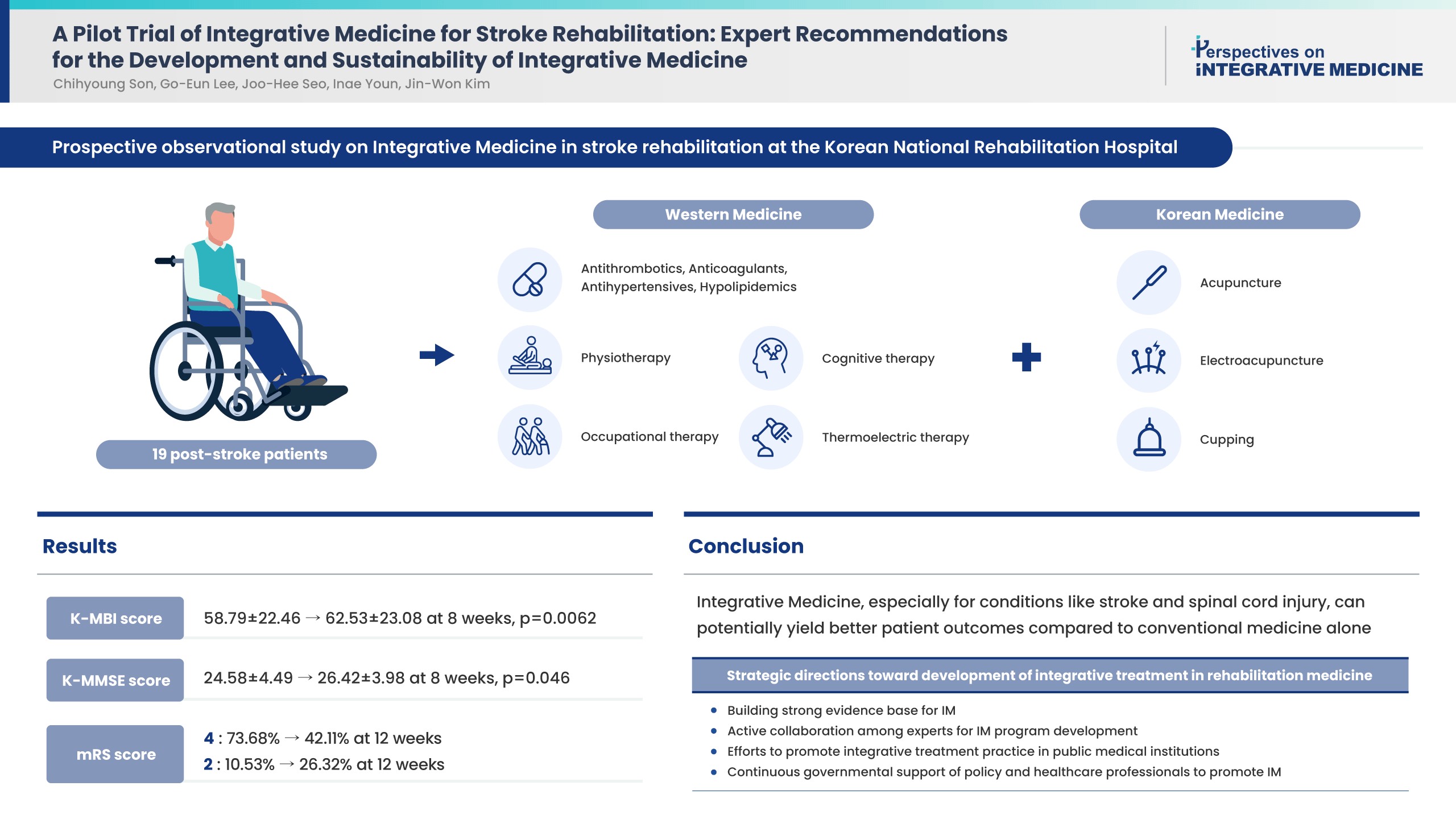
- Background
Strategies towards development and sustainability of integrative treatment in stroke rehabilitation medicine are needed. National expert recommendations based on the implementation of Integrative Medicine (IM) in stroke rehabilitation and IM outcomes would be invaluable.
Methods
A pilot study was performed and the effectiveness of combining Korean traditional medicine and Western conventional medicine in post-stroke patients (ischemic stroke n = 15 and hemorrhagic stroke n = 4) was evaluated, and recommendations were developed through consensus with physicians in national centers of rehabilitative medicine. Outcome measures [Korean Modified Barthel Index (K-MBI), Korean Mini Mental State Examination (K-MMSE), Modified Rankin Scale (mRS), and EuroQol 5-dimension 5-level (EQ-5D-5L) assessment were used at baseline, 4, 8 (K-MBI, K-MMSE, mRS, and EQ-5D-5L) and 12 weeks post treatment (EQ-5D-5L and mRS).
Results
Improvements were observed in functional and cognitive abilities at 8 weeks (K-MBI score p = 0.0062; K-MMSE score p = 0.046). Quality of life improvements (EQ-5D-5L) were observed but were not statistically significant. The disability assessment (mRS) indicated a gradual improvement from baseline to 12 weeks. No adverse events were reported. For effective, patient-centered IM treatment: (1) build a strong evidence base for IM as compared with Western medicine alone or traditional medicine alone; (2) active expert collaboration; (3) IM promotion in public medical institutions; and (4) continued government support.
Conclusion
Functional and cognitive abilities of stroke patients statistically significantly improved following 8 weeks of IM treatment. Strategies have been suggested towards the development and sustainability of IM treatment in stroke rehabilitation medicine.
Review Articles
- Characteristics and Quality of Traditional Chinese Therapies and Integrative Medicine Clinical Practice Guidelines for Musculoskeletal Disorders Published in Mainland China
- Xue-Feng Wang, Jing-Ling Zuo, Lin-Jian Li, Lan-Dan Xu, Xiao-Zhong Liu, Si-Si Ma, Jian-Ping Liu
- Perspect Integr Med. 2024;3(1):7-17. Published online February 22, 2024
- DOI: https://doi.org/10.56986/pim.2024.02.002
- 1,027 View
- 19 Download
-
 Graphical Abstract
Graphical Abstract
 Abstract
Abstract
 PDF
PDF Supplementary Material
Supplementary Material 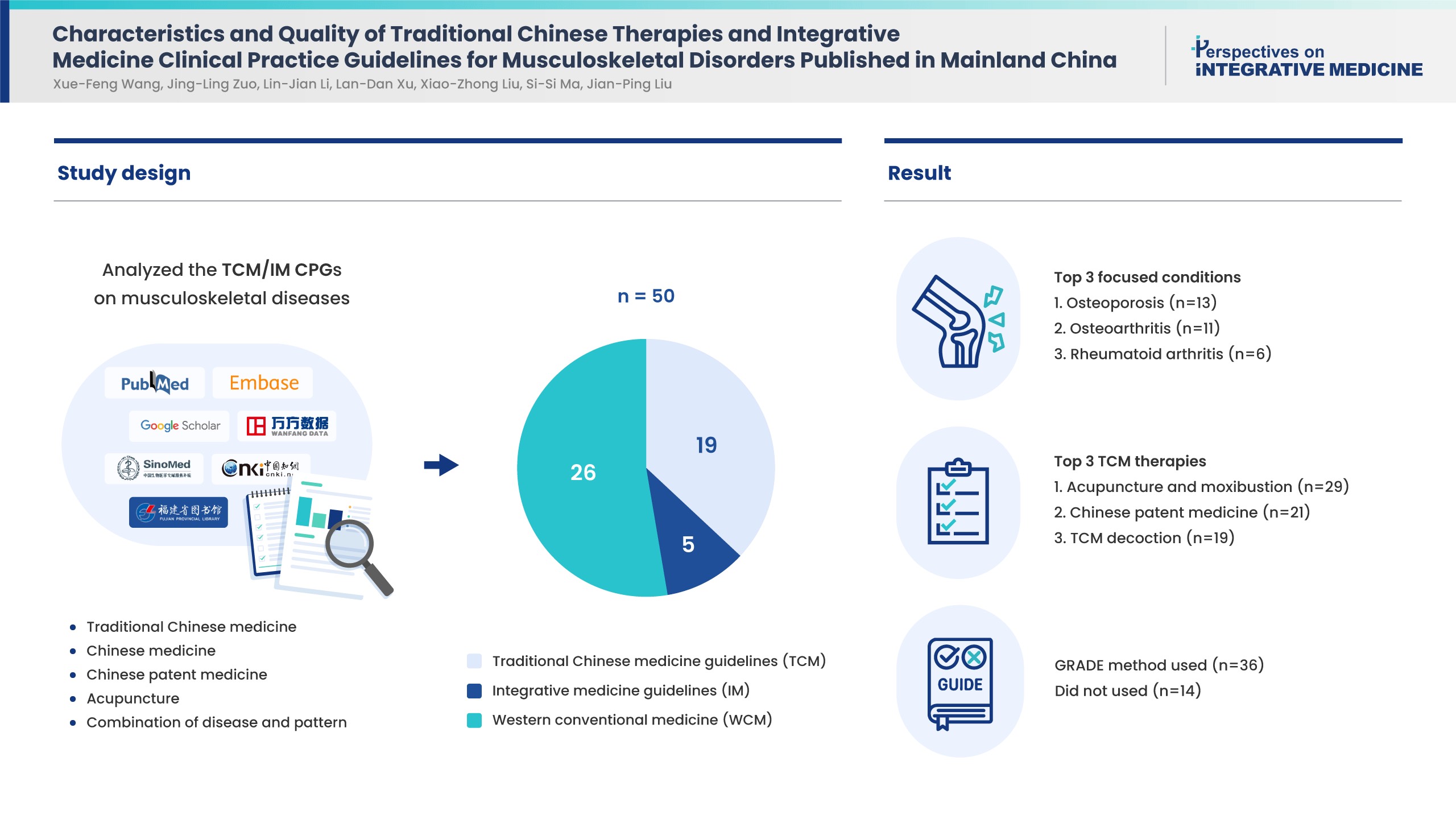
- Background
Musculoskeletal disorders are prevalent in adults. Traditional Chinese medicine (TCM) and integrative medicine (IM) are commonly used treatments which have clinical practice guidelines (CPGs). This study aimed to determine the characteristics and quality of these CPGs.
Methods
CPGs which recommended TCM/IM therapies in musculoskeletal conditions/diseases published in Chinese or English between January 2018 to December 2022 in mainland China were retrieved and analyzed for guideline classification, funding source, conflict of interest, and methodology. Appraisal of Guideline for Research and Evaluation Ⅱ including 6 domains, was applied to assess CPG quality.
Results
Of the 50 CPGs included, there were 19 TCM, 5 IM, and 26 western conventional medicine (WCM) guidelines of which osteoporosis (13, 26%), osteoarthritis (11, 22%) and rheumatoid arthritis (6, 12%) were the most frequent diseases. The TCM therapies recommended by the CPGs successively were acupuncture and moxibustion, Chinese patent medicine, and TCM decoction based on syndrome differentiation. Nearly half of the CPGs reported funding source (52%) and conflict of interest (48%). Thirty-six CPGs used the Grading of Recommendations, Assessment, Development, and Evaluations method to present summaries of evidence, the remaining did not report the method. Based on Appraisal of Guideline for Research and Evaluation Ⅱ scores, “clarity of presentation” scored the highest (55%), while “applicability” was the lowest (6%). No CPG was recommended without change, and 23 CPGs were not recommended.
Conclusion
The quality of CPGs for musculoskeletal conditions/diseases in China is generally low. Future CPGs should pay more attention to standardized developing procedures.
- A Modern Interpretation of Cold-Heat Pattern in Traditional Medicine with a Focus on Thermo-Regulation
- Younggwang Kim, Jee Young Lee, Joongho Lee, Sanghun Lee
- Perspect Integr Med. 2024;3(1):18-28. Published online February 22, 2024
- DOI: https://doi.org/10.56986/pim.2024.02.003
- 1,084 View
- 22 Download
-
 Graphical Abstract
Graphical Abstract
 Abstract
Abstract
 PDF
PDF Supplementary Material
Supplementary Material 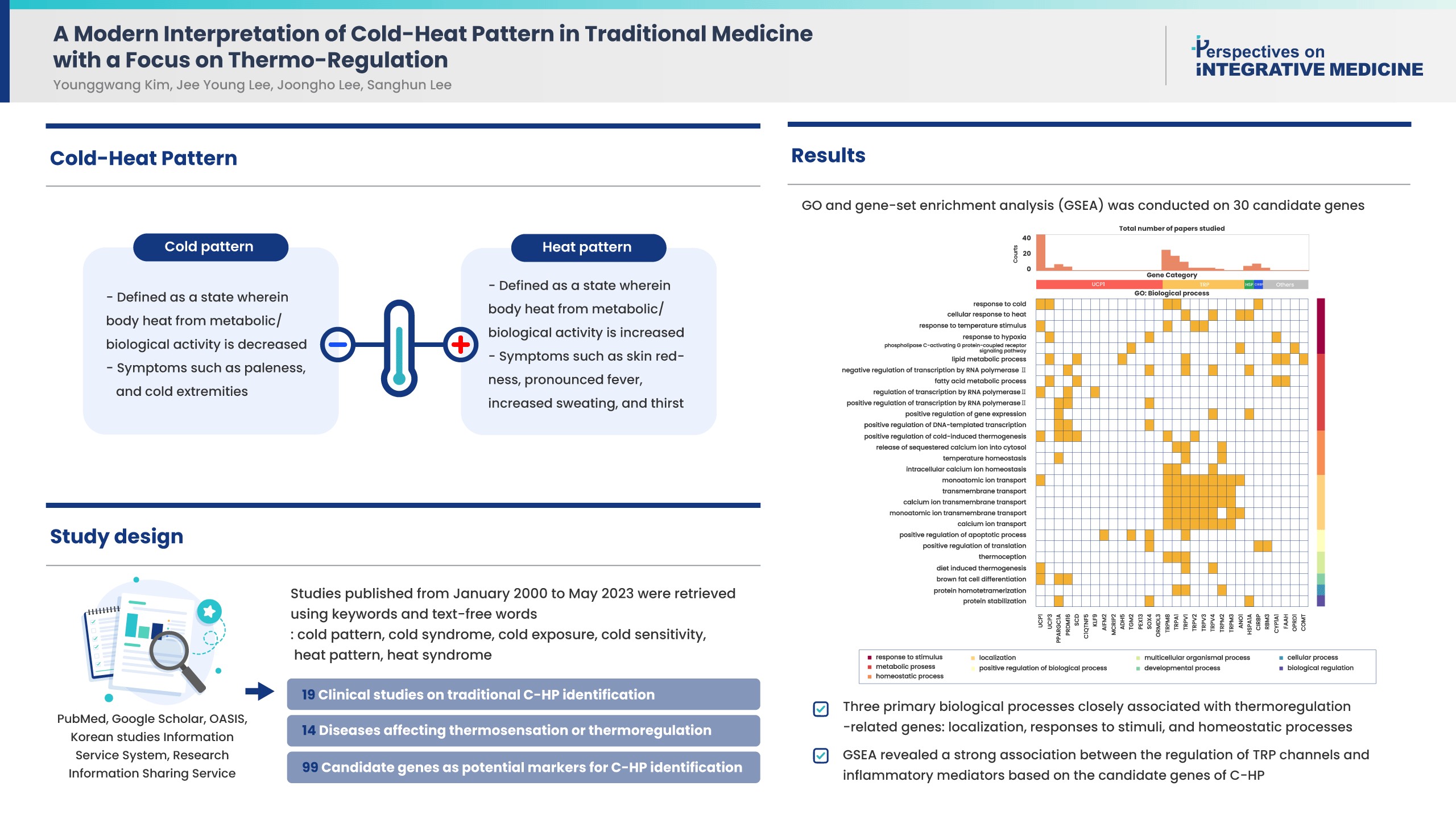
- Cold-heat patterns (C-HPs) in Traditional East Asian Medicine are essential for individually diagnosing and treating patients. However, the concept of C-HPs and their biological mechanisms (thermoregulation) remains unclear. C-HPs studies published between January 2000 and May 2023 were retrieved from 5 databases (PubMed, Google Scholar, OASIS, Korean studies Information Service System, and Research Information Sharing Service). Among the 8,373 articles screened, 132 were included in the review and categorized. Nineteen articles were clinical studies related to traditional concept of C-HP identification, 14 studies investigated diseases affecting thermosensation or thermoregulation, and 99 studies identified candidate genes as potential markers for C-HP identification. Further analysis, including gene ontology, and gene set enrichment analysis of the candidate genes, revealed 3 primary biological processes closely associated with thermoregulation-related genes, including localization, responses to stimuli, and homeostatic processes. Notably there was a significant association between the candidate genes and inflammatory mediator regulation of transient receptor potential channels (p < 0.001). A significant association between C-HPs and inflammation-related pathways across thermosensation-related and thermoregulation-related clinical and preclinical studies was observed, suggesting that the traditional concept of C-HPs should be studied further from an immunological perspective.
Original Articles
- Acupuncture Needles and the Risk of Lymphedema After Breast Cancer Surgery: A Retrospective National Cohort Study
- Ye-Seul Lee, Yucheol Lim, Jiyoon Yeo
- Perspect Integr Med. 2024;3(1):29-36. Published online February 22, 2024
- DOI: https://doi.org/10.56986/pim.2024.02.004
- 1,866 View
- 28 Download
-
 Graphical Abstract
Graphical Abstract
 Abstract
Abstract
 PDF
PDF Supplementary Material
Supplementary Material 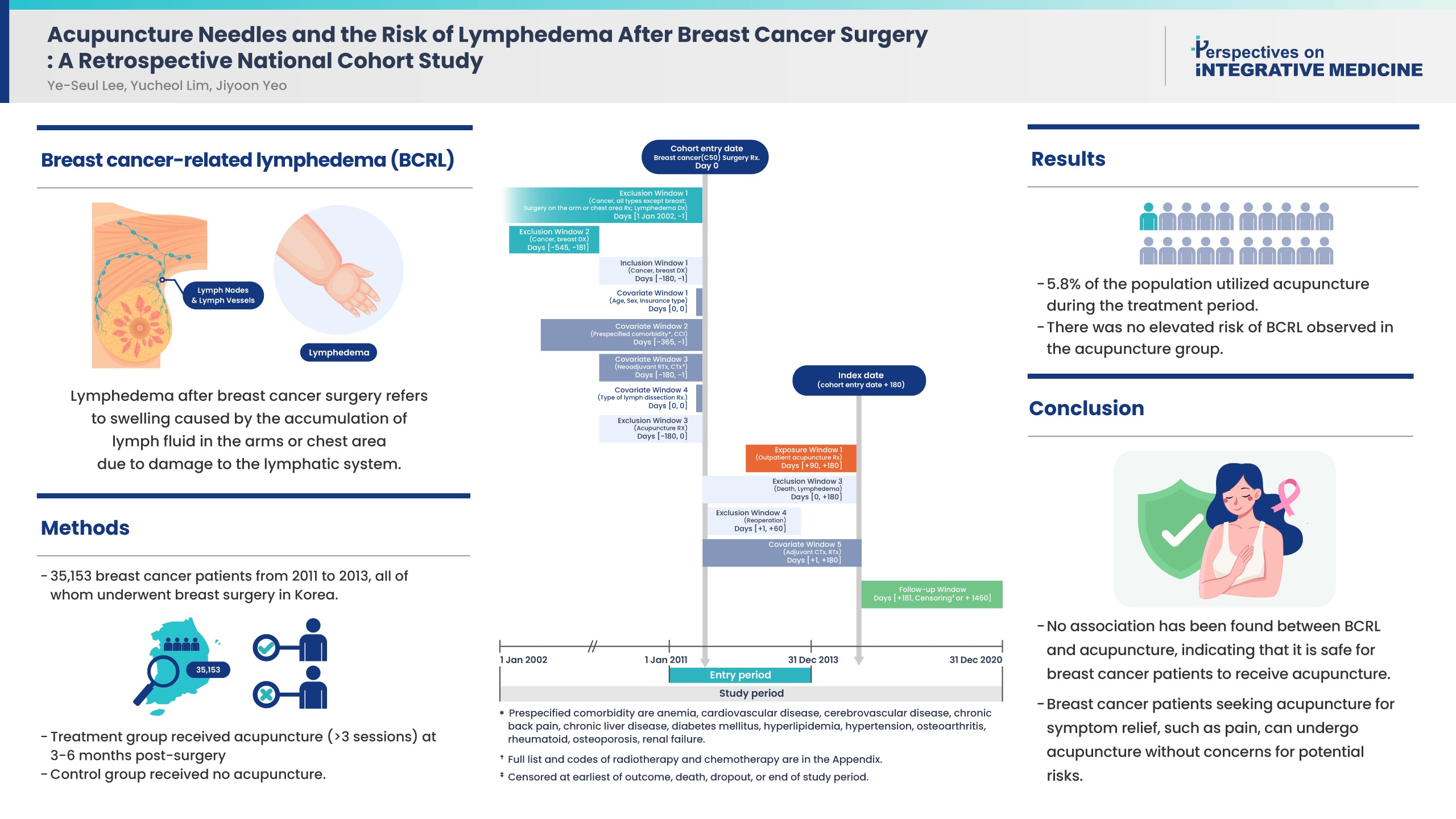
- Background
Controversies remain over the impact of using needles on breast cancer patients after surgery due to risk of breast cancer-related lymphedema (BCRL). While recent literature suggests that vascular access during the postsurgical stage does not affect the risk of BCRL, the impact of acupuncture on the risk of BCRL during the postsurgical stage has not been studied.
Methods
This study included 35,153 patients from 2011 to 2013 who were newly diagnosed with breast cancer in a population-based cohort from the Korean National Health Insurance Service database. All patients received breast surgery, and the treatment group received acupuncture for more than 3 sessions in the 3-6 months post-surgery. The control group did not receive acupuncture. The incidence rate ratio, Kaplan-Meier curve, and Cox proportional hazards models were used to compare the risk of BCRL, and death between groups.
Results
About 5.8% of the study population received acupuncture during the 3-6 months post-surgery treatment window. After propensity score matching, the acupuncture treatment group did not show an increased risk of BCRL (IRR 1.017, 95% CI 0.868-1.193; unadjusted HR 1.018, 95% CI 0.868-1.193). This risk was robust in all multivariate Cox proportional hazards models.
Conclusion
An association of BCRL with acupuncture was not observed. Patients who received acupuncture to manage symptoms such as pain during the 3-6 months postsurgical stage did not have a higher risk of developing BCRL. Breast cancer patients who seek acupuncture to alleviate post-surgery symptoms such as pain, can receive acupuncture without concerns for potential risk of BCRL.
- Effects of Pulsed Electromagnetic Field Therapy and Photontherapy in Cervicobrachialgia: A Randomized Controlled Trial
- Bianca dos Santos Bobadilha, Talita Bonato de Almeida, Maria Imaculada de Lima Montebello, Maria da Luz Rosário de Sousa
- Perspect Integr Med. 2024;3(1):37-44. Published online February 22, 2024
- DOI: https://doi.org/10.56986/pim.2024.02.005
- 1,066 View
- 19 Download
-
 Graphical Abstract
Graphical Abstract
 Abstract
Abstract
 PDF
PDF 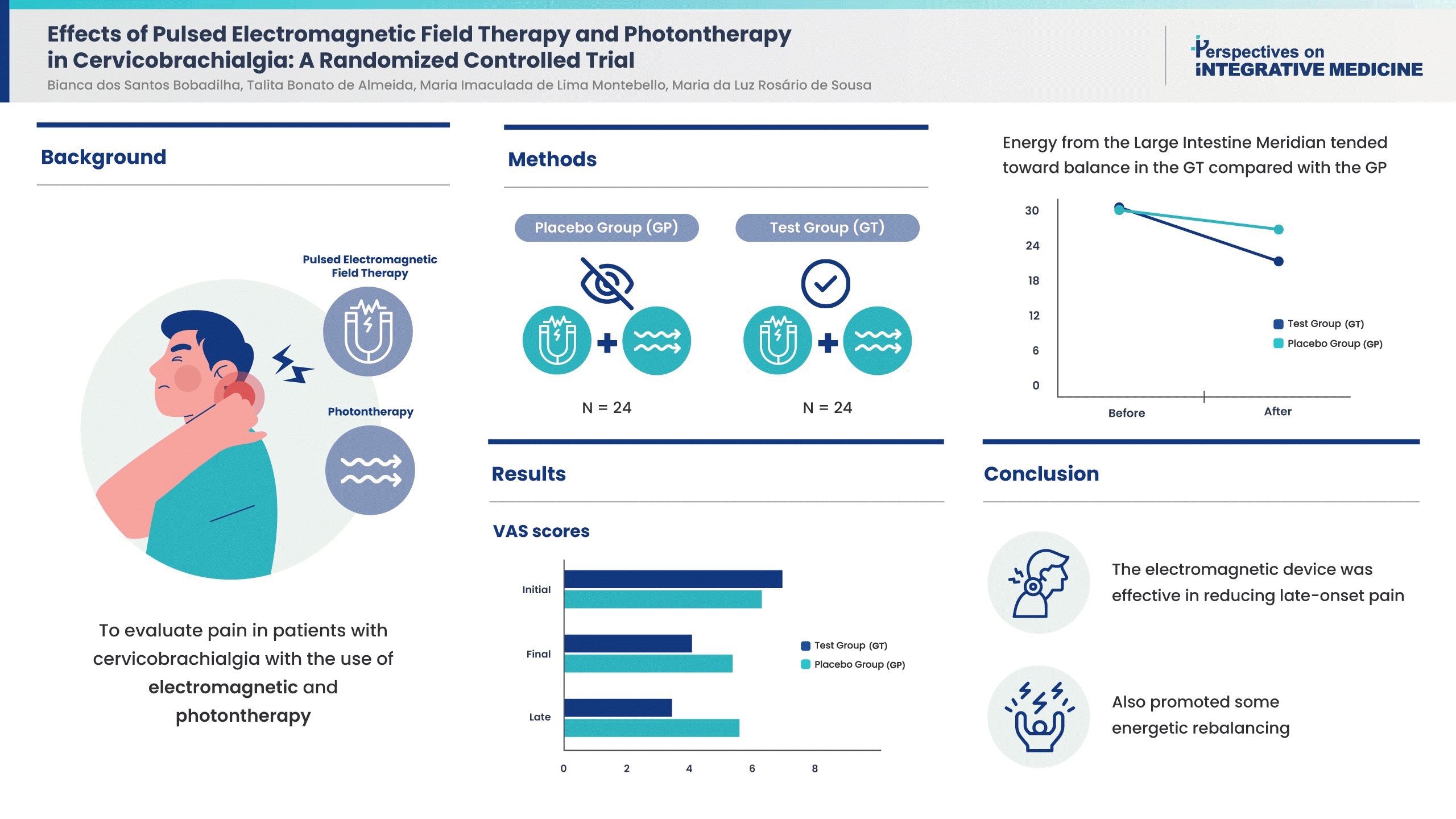
- Background
Cervicobrachialgia is a painful condition commonly treated with medication and physiotherapy. The aim was to evaluate pain following electromagnetic and photontherapy, and examine patient energy profiles.
Methods
There were 48 patients experiencing pain [Visual Analogue Scale (VAS) score ≥ 4] who were not receiving medication and physiotherapy and were randomized into Test Group (GT); electromagnetism using a Kenkobio device (intensity = 0.055 mT/frequency = 60 Hz) and photon therapy; a photon therapy blanket, and Placebo Group (GP); the Kenkobio device was turned off and the blanket was not used. Pain was assessed using the VAS, before, immediately after treatment, and the following day. Algometry was also carried out before and after the treatment to understand the pain threshold at bilateral acupoints GB20 and GB21. The energy profile was assessed using Ryodoraku measurements before and after the session.
Results
The GT achieved a greater reduction in pain the following day than GP. Both groups were equal for left GB20 and right GB21 points considering algometry and, after the intervention, a reduction in pain in the GT was noticed only in the left GB20 (CI [95%]: 0.09-0.99, p = 0.019). The average energy level was low and dropped further following treatment. Furthermore, energy from the Large Intestine Meridian tended towards balance in the GT compared with the GP [CI (95%): 0.58-15.75, p = 0.035]. No adverse effects were reported.
Conclusion
The combined use of electromagnetic and photontherapy were effective in reducing pain in patients and promoted energy rebalancing.
- A Survey of the Clinical Practice of Korean Medicine for Smoking Cessation in Public Health Centers: A Web-Based Survey of Public Health Doctors of Korean Medicine
- Gyoungeun Park, Jeong-Hyun Moon, Eun-Jung Kim, Byung-Kwan Seo, Yong-Hyeon Baek, Won-Suk Sung
- Perspect Integr Med. 2024;3(1):45-50. Published online February 22, 2024
- DOI: https://doi.org/10.56986/pim.2024.02.006
- 1,213 View
- 13 Download
-
 Graphical Abstract
Graphical Abstract
 Abstract
Abstract
 PDF
PDF Supplementary Material
Supplementary Material 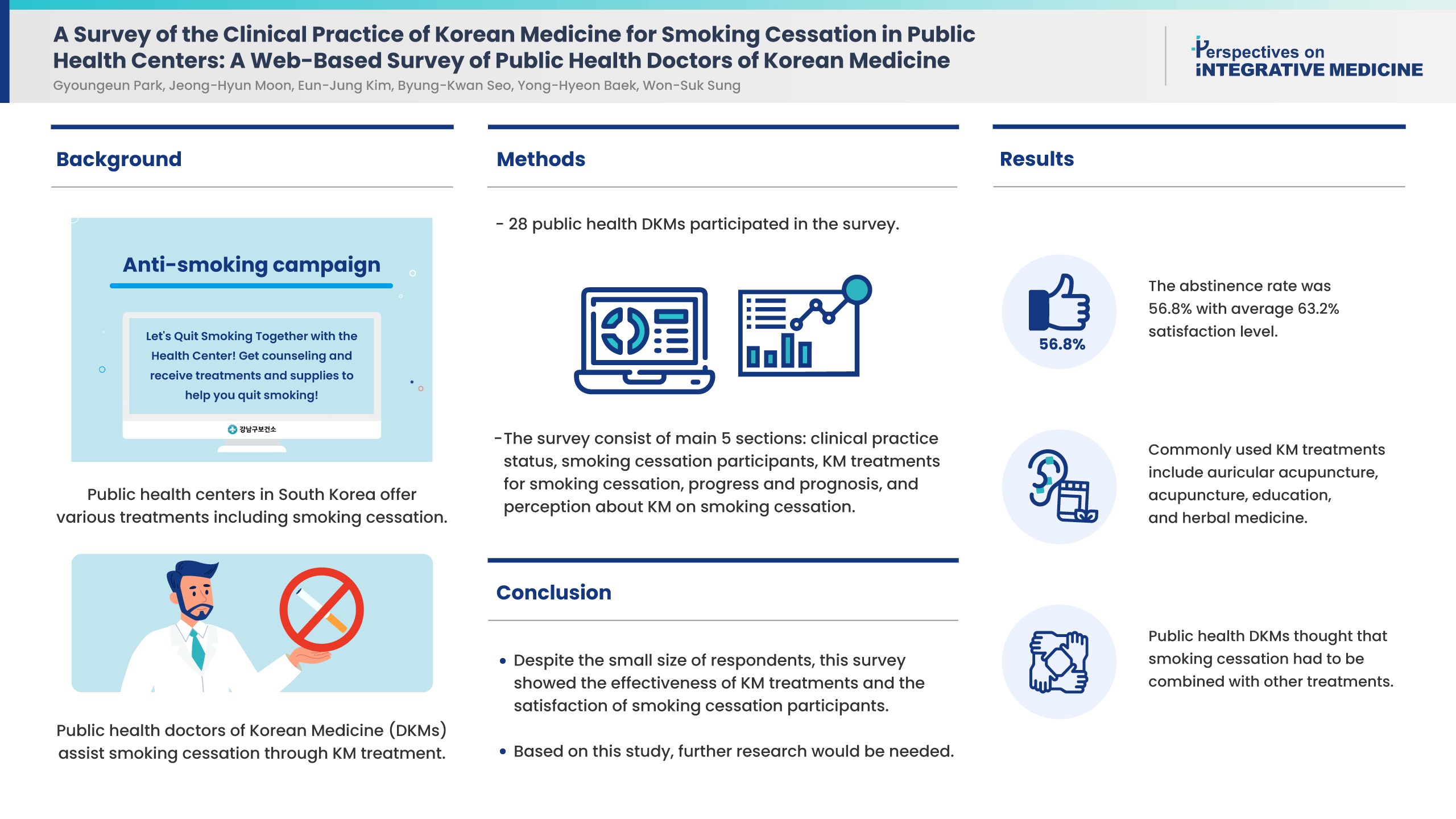
- Background
In South Korea, public health centers provide smoking cessation (SC) treatments including behavioral therapy and nicotine replacement treatment. Also, public health doctors of Korean medicine (PHDKMs) are providing Korean Medicine (KM) treatments. Several studies have reported the clinical usefulness of KM treatment, but in this study, the opinion of PHDKMs was explored to examine the current KM treatments for SC.
Methods
A web-based survey (Moaform) of the treatment for SC by PHDKMs consisted of 5 main sections including clinical practice status, SC participants, KM treatments for SC, progress and prognosis, and perception of KM. The survey was emailed twice to 621 PHDKMs on April 6 to 20, 2022. The frequencies and percentages of each question were calculated.
Results
There were 28 PHDKMs who participated in the survey. Among them, over 90% of PHDKMs had treated ≤ 10 SC participants, and about 10% of PHDKMs had treated 11-20 participants. The abstinence rate was 56.8% with an average 63.2% level of satisfaction in the treatment. Typically used, and recognized as important KM treatments, were auricular acupuncture, acupuncture, education, and herbal medicine. While auricular acupuncture and education were perceived as convenient KM treatment, PHDKMs thought that SC could not be achieved with KM treatment alone and needed be combined with other treatments.
Conclusion
This survey showed the effectiveness of KM treatments with withdrawal symptoms, and treatment satisfaction of SC participants. Respondents also thought that KM treatment combined with other treatments is more effective than KM monotherapy. Based on this small study, further research would be needed.
Case Report
- Complete Remission of Drug-Induced Acute Dizziness Using Eight Constitution Acupuncture and the Barbecue Maneuver: A Case Report
- Younkuk Choi, Juhee Cho
- Perspect Integr Med. 2024;3(1):51-56. Published online February 22, 2024
- DOI: https://doi.org/10.56986/pim.2024.02.007
- 1,402 View
- 51 Download
-
 Abstract
Abstract
 PDF
PDF - Dizziness, often symptomatic of underlying conditions, presents management challenges especially when dealing with drug-induced vestibular disorders. Complementary therapies like acupuncture, specifically, Eight Constitution Acupuncture (ECA), offers a potential alternative to other management therapies. A 74-year-old female, experiencing sudden dizziness from medication for back pain, underwent a detailed examination, constitutional diagnosis, and targeted acupuncture involving 26 insertions over 4 sessions. The treatment for dizziness, which focused on constitutional differences, integrated ECA and the barbecue maneuver which resulted in significant efficacy. A 50% reduction in the Numeric Rating Scale score from 10 to 5 was observed after the 1st session. Subsequent sessions of ECA combined with the barbecue maneuver significantly reduced symptoms of dizziness and ultimately alleviated symptoms. This case underscored the potential of ECA when combined with the application of the barbecue maneuver in treating drug-induced vestibular disorders and residual benign paroxysmal positional vertigo. The ECA's constitutional approach allows for precise targeting and symptom resolution, and integrating the principles of Traditional Asian Medicine with biological mechanisms. Notably, this is the 1st case report of the efficacy of ECA and the barbecue maneuver in addressing drug-induced vestibular disorders. A holistic approach, considering constitutional differences, can offer insights and tailored solutions to present a promising avenue for patients experiencing such conditions. Rigorous research studies are essential to validate these findings.
Protocol
- Validation of a New Sham Acupuncture Needle for Double-Blind Trials: A Study Protocol
- Sung Min Lim
- Perspect Integr Med. 2024;3(1):57-60. Published online February 22, 2024
- DOI: https://doi.org/10.56986/pim.2024.02.008
- 1,922 View
- 14 Download
-
 Abstract
Abstract
 PDF
PDF - Background
To establish efficacy in acupuncture treatment, rigorous randomized controlled trials (RCT) are needed. Non-invasive sham acupuncture needles are an effective tool for practitioner/participant blinding. This study presents a protocol for the validation of a newly developed sham acupuncture needle.
Methods
A double-blind RCT will be conducted on 66 healthy adults who will be randomly assigned (using computer-generated random numbers) to either the verum (n = 33) or sham (n = 33) acupuncture needle group. The needles will be inserted at 2 acupuncture points: LI4 (upper limb) and ST36 (lower limb). The primary outcome measure is the practitioner/participants belief that they received verum or sham acupuncture. The secondary outcome measures are participant-rated sensations (penetration, pain, and de qi). Adverse events will be recorded with detailed explanations, categorizing occurrences according to related or unrelated to acupuncture. As the newly developed sham acupuncture has not been studied before, an exploratory approach has been adopted. Descriptive statistics, t test, and χ² test will be applied appropriately.
Results
This study is intended to provide a protocol for the validation of a sham acupuncture needle by using a double-blind RCT setting, and the results will hopefully contribute to the standardization of the needles used for sham acupuncture. The outcomes aim to determine the reliability of practitioner/participant blinding, participant experience of sensations, and lay groundwork for a standardized control group for clinical trials in the future. The newly developed non-invasive sham acupuncture needle may reduce bias and improve reliability in the size effect of acupuncture treatment.
Letters
- Treatment Recommendations in Korea for Patients with Axial Spondyloarthritis: The Evidence for Acupuncture Treatment in Axial Spondyloarthritis Patients Should be Re-evaluated
- Tae-Hun Kim, Myeong Soo Lee, Hyangsook Lee, Stephen Birch, Terje Alraek
- Perspect Integr Med. 2024;3(1):61-62. Published online February 22, 2024
- DOI: https://doi.org/10.56986/pim.2024.02.009
- 1,007 View
- 16 Download
- Tendon Rupture by Acupuncture? Reporting of Not Probable Causality Might Exaggerate Harm of Acupuncture
- Sung-A Kim, Tae-Hun Kim, Jung Won Kang
- Perspect Integr Med. 2024;3(1):63-64. Published online February 22, 2024
- DOI: https://doi.org/10.56986/pim.2024.02.010
- 15,629 View
- 15 Download




 First
First Prev
Prev


